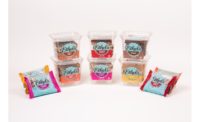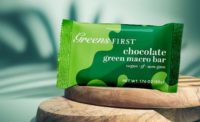
There’s never been a better time to purchase snack bars. That’s because there have never been so many options on the market in this diverse category, whose claims to fame include kosher, organic and vegan certifications, as well as protein and fiber. New products also offer allergy-stricken consumers gluten-, soy- and dairy-free options.
In short, there’s a snack bar for everybody, from children and students to office workers and stay-at-home moms, even athletes in collegiate sports programs - a core audience for Boca Raton-based EB Performance, whosePB & Whey Bitesare “compliant for college athletics,” according to product packaging.
The success of the category stems largely from interest in more healthful, portable snacks.“More and more people are taking a proactive approach to their health,” asserts Susanne Norwitz, director of Brand PR for Kellogg Co., Battle Creek, Mich., adding that consumers are looking for “healthy options to fit their busy lifestyles.”
At retail, natural and health food stores are the perfect venue for many of the aforementioned offerings, as noted in a recent Euromonitor report, “Snack Bars in the U.S.” But bars also have a high penetration in c-stores, the research firm points out.
“The easy-consumption and meal replacement qualities have high appeal to on-the-go consumers in the convenience channel,” the study states.
All in all, “Snack bars in the USA are maturing,” Euromonitor says, and sales remain vibrant due to the high degree of differentiation within the category, which serves many consumer needs.
Although growth should remain steady moving forward, it is expected to “slow significantly” from the category’s previous boom, Euromonitor adds.
Indeed, other studies show that sales of snack bars aren’t as robust as they used to be.As reported in the Dec. 16, 2009, edition ofsweet & healthyeNewsletter, this once chart-climbing category is finally easing up, at least according to Dutch-based Innova Database.
After years of sustained growth in the United States, an Innova Market Insights overview concludes that snack/cereal/energy bar sales through supermarkets, drugstores and mass merchandisers showed only slight growth in the first half of 2009, although nutrition and intrinsic health bars, including energy bars, performed better than breakfast bars and rice snack squares.
“Within the nutrition bars market, traditional-style energy bars are having to compete with a range of other health-oriented bars, not only those positioned on a general or multibenefit platform, but also on a range of formats that are currently very much in vogue, including whole-grain, high-fiber, weight management, digestive health, free-from and natural,” explains Lu Ann Williams, head of research for Innova Market Insights.
She emphasizes that “with the high levels of product activity apparent in the bars market in recent years, it may be that saturation point is approaching, with market maturity and segmentation reaching a point where further innovation opportunities are going to be more limited, possibly causing further shakeouts in the market and creating an even more challenging environment.”
Case in point: Northfield, Ill.-based Kraft Foods recently sold itsBalance Barnutrition bar business to a private equity firm, saying that its interests currently are focused in other areas.

That’s not to say that snack bar producers aren’t still innovating. On the contrary, manufacturers in this category have plenty to offer. And Information Resources, Inc. reveals that sales of certain branded products actually are on the rise, depending on variety and health claim.
For example, San Francisco-based Amazing Grass has reported triple-digit growth.“Based on consumer rationings, our bars are well-received because they offer a significant amount of high-quality ingredients and no fillers,” says Todd Habermehl, co-founder of the company. “The fact that we have made green foods taste great is an easy proposition to sell.”
Then there’s self-declared “start-up company” EB Performance.
“So far this year, we are increasing our monthly sales considerably and are gaining lots of traction in our Florida market and will be strategically expanding to other regions of the country throughout 2010,” says company co-founder Daniel Schapiro.
Last year, Columbus, Ohio-based Abbott Nutrition’sZonePerfect brand gained share in the nutrition bar category, too, according to Julia Stoner, senior brand manager forZonePerfect Nutrition Bars.
“So far, indications show that 2010 will be even better than 2009,” she says. (See “Beyond Borders” sidebar.)
What’s taking some snack bar producers to the top? Leaders in the category boast multiple health claims in their efforts to capture share of stomach from every shopper.
Organic Options
As a small but mighty niche within the food industry, organics continue to play a role in new product introductions, despite a down economy. Organic confectionery sales represent just 2% of market share in the total confectionery marketplace. But according to a recent article inCandy Industrymagazine (“Back in the Race,” October 2009), the top-selling organic confectionery category is energy bars ($147.2 million), followed by snacks ($82.6 million) and candy ($48.2), Curtis Vreeland writes.However, he says, “It’s important to note that categories within the organic confectionery market differ significantly from those in the total confectionery market. Energy bars comprise 53% of organic confectionery sales, but only 4% of the total confectionery market, reflecting the importance of lifestyle and wellness products for organic consumers.”
Recently introduced organic energy bars include Clif Bar’sLuna Minis, an all-natural product that’s made from 70% organic ingredients. Each bite-size mini contains nutrients such as calcium, folic acid, iron and protein. They come in three chocolatey flavors: S’Mores, Nutz Over Chocolate and Caramel Nut Brownie.
Clif Bar, Berkeley, Calif., also has come out with a new double-layer fruit and nut snack calledClif C. The lightly baked bar is sprinkled with nuts and a hint of sea salt, and contains a full serving of fruit. Like Clif Bar’sLuna Minis,Clif Cis an all-natural product that’s made from 70% organic ingredients. It’s also trans fat-free, vegan, vegetarian and certified kosher, and is a good source of fiber, containing just 4.5 g. of total fat. Clif C comes in four varieties: Blueberry, Cherry Pomegranate, Apple and Raspberry.
Other organic snack bars on the market include Amazing Grass’s certified Organic Whole Food Energy Bar line, which features four SKUs: Original, Chocolate-covered, Chocolate Peanut Butter Protein and Berry Infusion. Each features antioxidants, omega fats, fiber, protein, 18 amino acids and 21 vitamins and minerals. Like all Amazing Grass brand products, the bars also are cold-processed, raw, vegan and gluten-, soy- and dairy-free, calling to mind other trends in the category.
Protein Packers
As previously mentioned, fiber and protein are popular ingredients in today’s best-selling snack bars.EnterKellogg’s FiberPlus Antixodants Bars, which deliver 35% of your daily fiber, plus antioxidants Vitamin E and zinc, and are available in Chocolate Chip and Dark Chocolate Almond varieties.
When it comes to protein, several manufacturers are moving forward.
Take the new Chocolate Peanut Butter Protein Bar from Amazing Grass, which combines antioxidant-rich fruits and vegetables from the brand’s alkalizingGreen SuperFood Powderwith organic peanuts and whey protein. The gluten-free bar offers five-plus daily servings of fruits and vegetables, and contains every nutrient the body needs (except for Vitamin D, which is processed naturally from sunlight). It also boasts 12 g. of protein, 270 calories, 14 g. of omega fats, 19 g. of sugar and 28 g. of carbohydrates. Most ingredients in the product are organic to boot.
The protein story continues over Las Vegas-based Chef Jay’s Food Products, maker ofTri-O-Plex Skinny Dipped Protein Bars, which come in three flavors: Chocolate Peanut Butter, German Chocolate and Yogurt Peanut Butter. Each all-natural bar contains 31 g. of protein. In addition, Chef Jay’s offersTri-O-Plex, available in Chocolate Coconut, Smores, Caramel Apple and Peanut Butter Chocolate Chip. Its new filled-centerTri-O-Plex Duocomes in Peanut Butter and Jelly Sandwich, Bursting Peanut Butter and, now, Caramel Peanut Butter flavors.Then there’s EB Performance, whose products all contain whey protein and are sweetened with organic agave nectar, a low-glycemic sweetener.
EB Performance (EB meaning “Every Body”) first entered the snack bar market when “we could not find protein bars that combined the great taste and the healthy ingredients we desired or felt the majority of active individuals desired,” Schapiro says. Although the line between candy bars and protein bars appears to be blurring, he adds, due to the number of introductions containing artificial sweeteners and preservatives, “consumers are becoming much smarter, and products have to adapt to this.”
Consumers often compare the flavor of EB Performance’sPB & Whey Protein Bites to confectionery classics such asBit-O-HoneyandMary Janes, Schapiro notes. The American-made, “high-energy” product currently comes in an original variety, but soon will be available in two new choices: Organic Peanut Butter with Organic Dark Chocolate Chip and Organic Peanut Butter with Almonds and Raisins. Each gluten-free product offers 10 g. of protein.
Meanwhile, Carson City, Nev.-based Forward Foods LLC’s Detour Lean Muscle whey protein bar boasts 32 g. of protein per serving and just 3 g. of sugar as well as 2,000 mg. of Omega-3s. Flavors such as Fudge Almond Crunch keep consumers from feeling like they’re eating something that’s more good-for-you than good-tasting.
After all, the best new products take into consideration the adage about health-conscious consumers who want to eat healthy, but not at the expense of their taste buds.“The key is bridging the gap between nutrition and taste so people keep buying your product,” Schapiro asserts.
Norwitz takes that assertion one step further.
“The challenge for companies today is to offer products that not only provide great taste and nutrition, but also give consumers the freedom to keep up with their busy lives,” she says.
If snack bar producers remain as busy as they have been coming up with products that meet these goals, then shoppers are sure to follow.
Sidebar: Beyond Borders
Abbott Nutrition’sZonePerfectbrand has become a household name. Since the acquisition ofZonePerfect Nutrition Bars in 2003, Abbott has built a range of products under theZonePerfect umbrella. It currently offers 21 varieties, includingZonePerfect Classic Chocolate Peanut Butter Mousse - a fan favorite, according to Julia Stoner, senior brand manager.Recently, the company extended the line beyond typical snack bar borders with the introduction of newZonePerfect Indulgence Nutrition Squares. The dessert-inspired snacks come in three varieties: Chocolate Peanut Butter Mousse, Caramel Toffee and German Chocolate Cheescake. Despite their decadent descriptions, each square delivers a healthy profile in the form of 18-19 vitamins and minerals, and is an excellent source of 10-11 g. of protein.
“The ZonePerfect team doesn’t think that you should have to choose between what you enjoy and what is good for you,” Stoner says, “and lately, people are demanding more sophisticated flavors.ZonePerfectNutrition Bars and newZonePerfect IndulgenceNutrition Squares prove that decadent flavor and healthy living can go hand-in-hand.”
For more information, visitwww.zoneperfect.comorwww.abbottstore.com.




